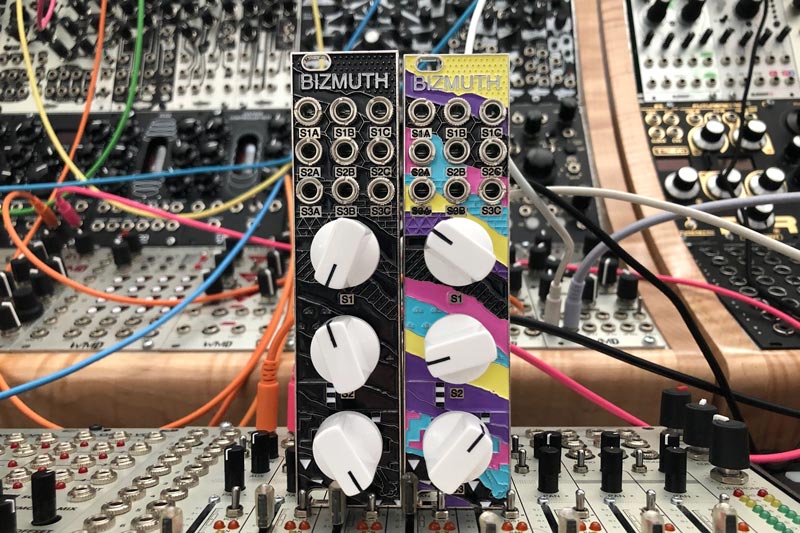Bizmuth Modular's first module—the eponymously named Bizmuth—is a simple, yet surprisingly flexible tool for sonic expression. While it may look on paper as if it is "simply a signal router," it opens up avenues of expressive performance that highlight some of the most wonderful, exciting, and surprising aspects of modular synthesis.
In the video above, we use Bizmuth as a signal router and as a gate generator—though its potential applications seem endless.
Performative Signal Routing
At its core, Bizmuth is three independent bi-directional switches, each operated by a dedicated knob. You can use these switches to route a single source to up to two destinations, or to route one or two sources to a single destination. Each of the three switches has three jacks: either an input and two outputs, or vice versa. Functionally, that is fairly straightforward—but the interesting part lies in how the switching is operated.
Rather than using toggles or buttons, these switches are operated by custom, endless rotary knobs. And these don't feel like your typical modular potentiometers: the response is super smooth and sensitive, making it easy to turn them with even the slightest amount of pressure. You don't necessarily need a full grip on the knobs to get them to work their magic—a simple brush of the hand along the side is enough to turn them. Despite this sensitivity, these knobs are surprisingly sturdy, which in combination with the enamel panel makes this module feel uncommonly rugged.
What's even more interesting is the way that these knobs interact with the internal switches. Rather than a full turn of the knob switching between only a couple preset configurations, 360 degrees of rotation selects between 96 switch configurations—meaning that internal connections are altered every 3.75 degrees of rotation, with a repeating sequence of four specific switch configurations. Along with the feeling of the knobs, this takes the Bizmuth out of the realm of utility switching makes it a compelling performance tool: with that degree of sensitivity, it turns signal routing into a dynamic, unpredictable control source, perfect for feedback routing, sporadic macro patch control, and more.
 Black and classic colorful Bizmuth modules side by side.
Black and classic colorful Bizmuth modules side by side.
And while Bizmuth can function passively, connecting it via 16-pin ribbon to a +5V-equipped Eurorack power supply can turn it into a gnarly gate source. By employing a normalized connection from the +5V source to each B jack, Bizmuth makes it possible to turn simple physical gestures into intense flurries of gates. As such, it is great for triggering insane, concentrated bursts of noise or for carefully-contemplated unpredictability with subtler physical interaction.
Turning the act of patch routing into a performative tool, this module is a simple utility from which countless new performance techniques could be derived: it basically allows you to randomize your patch routing with a subtle brush of the hand. Its clever parameterization elevates it from its core functionality into something entirely new—revealing a special kind of creativity that leaves us excited to see what Bizmuth Modular will make next.







